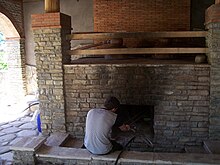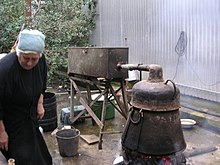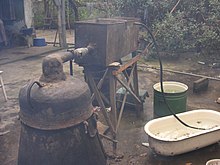Chacha
Tschacha ( Georgian ჭაჭა) is a traditional Georgian pomace brandy . It is industrially produced from grapes of white grape varieties, and also from fruit when distilled black .
Chacha was originally a by-product of winemaking for private use. Even today it is widespread in this form in the country and the distillery for personal use is part of subsistence farming. Georgian farmers use alongside wine and figs , tangerines , oranges , or mulberries , this fruit brandy correctly in Georgia Araki is called. In everyday language it is also called Georgian vodka or grape vodka , depending on the raw material . After the distillation, Chacha has an alcohol content of 70% vol and is therefore diluted to drinking strength with water. Chacha made privately has no fixed alcohol content. Chacha is stored for at least six months to mature.
In the 19th and 20th centuries , Chacha became an industrial product. The manufacturing process has been refined and only grapes are used as raw material. Some manufacturers store the pomace brandy in old oak barrels to improve the taste, so Chacha also absorbs some color. Industrially produced chacha is mild and has a slightly aromatic grape taste. Its alcohol content is 45% vol. It is usually filled in 0.5 liter glass bottles, some manufacturers have their own bottle designs.
Chacha is usually drunk neat, preferably ice cold and served with a lemon peel. However, it can also be used for cocktails. In rural areas of Georgia, it is common to have a glass of chacha in the morning, especially in cold weather. In the western regions of the country it is often drunk with a sweet snack. In Eastern Georgia it is consumed before salty dishes.
Commercial and private production

Since private distilleries for private purposes are tax-free in Georgia, even with home-made stills, both private, non-professional production and professional production for commercial purposes take place. Both are considered part of Georgian culture. The circumstances under which production takes place are shown by the respective photos.
left: The left picture shows a traditional private production. The fire under the copper kettle does not allow precise temperature regulation. The separation of toxic methyl alcohol from the desired ethanol (pleasure alcohol) cannot be adequately guaranteed. Often the private distiller has no tools whatsoever to measure the alcohol content and has to rely on his sense of smell and taste as well as on his experience.
right : Professional production of chacha in Tbilisi. A schnapps burner regulates and controls the gas flame below the kettle. The entire facility is permanently installed at this location and has been built to be stable for this purpose.
Miscellaneous
In the summer of 2012, a fountain will be opened in the Black Sea city of Batumi , from which Chacha will bubble. The mayor of the city hopes that this will boost tourism, which plays an important role in the region.
According to the then Soviet ambassador to Washington , Andrei Andrejewitsch Gromyko , Josef Stalin gave Franklin D. Roosevelt and Winston Churchill a bottle of Chacha during the Yalta Conference in 1945 and explained to them: “In my opinion this is the best of all types of vodkas. However, I don't drink it. I prefer light dry wines. "
swell
- ↑ Free alcohol for tourists, article on focus.de, accessed on March 31, 2012 at 11 p.m. [1]
- ^ AA Gromyko: Memories . Econ Verlag, 1989. ISBN 3-430-13525-7 . Corresponding excerpt in Russian here


